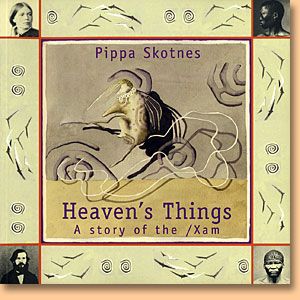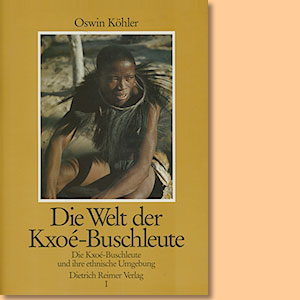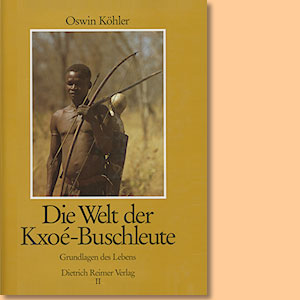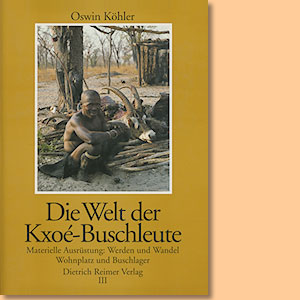Miscast: Negotiating the Presence of the Bushmen, by Pippa Skotnes
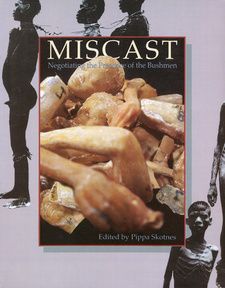
Miscast: Negotiating the Presence of the Bushmen, by Pippa Skotnes et al. University of Cape Town Press. Cape Town, South Africa 1996. ISBN 0799216526 / ISBN 0-7992-1652-6
Edited by Pippa Skotnes, the big, thouroghly illustrated and famous catalogue Miscast, Negotiating the Presence of the Bushmen explores the term "Bushman" and the relationships that gave rise to it.
Pippa Skotnes John Parkington Alan G. Morris
On 14 December 1995 Cecil Ie Fleur asked the South African parliament, on behalf of the Griqua people, to intervene in the return of the plaster cast and skeletal and other remains of Saartje Baartman, the young woman who was publicly displayed at salons, fairs and animal acts in London and Paris from 1810 to 1815, when she died. This plea followed a letter sent to the French government in which the authorities were requested to return Saartje Baartman to the Griquas, the "guardians and custodians of continuous, uninterrupted and unbroken Cape Aboriginal Khoikhoi heritage" (Cape Times 12 December 1995). The Griqua National Conference of South Africa is the latest group to join in the campaign demanding her return and burial. Why has the pitiful life, and fate after death, of Saartje Baartman become the focus of so much concern and action? Saartje Baartman is a potent symbol of the humiliation suffered by indigenous people in general and indigenous South Africans in particular. I knew something of her history through Penny Siopis' research and her paintings; I knew that the Musee de l'Homme in Paris housed the plaster cast made upon her death, as well as her skeleton and sexual organs. None of it, however, prepared me for the encounter with Saartje Baartman's death cast at Musee d'Orsay, in May 1994, on an exhibition entitled La sculpture ethnographique de la Venus hottentote a la Tehura de Gauguin. The naked horror of her plight and suffering, the sense of untold pain and shame, and the knowledge that it was part of my own history, were overwhelming. Saartje Baartman has become a focus of the way in which human beings were used by eighteenth- and nineteenth- century theorists of race to prove the superiority of Europeans; she stands for all those who were reduced to specimens and scientific information. Her people were regarded as closer to the animal kingdom than to humankind, or at least among the most primitive of human types. As a result, they became the most brutalised people in the history of southern Africa - victims of genocide and slavery, stripped of their land and the fabric of their lives and their culture. Until recently, Khoisan resistance to the colonial powers and settler developments has remained unrecorded in our history books, their interaction with and cultural influence on other groups has been ignored, and the astonishing art created on the surfaces of rocks excluded from art history books and art museums. The people were portrayed as wild, as murderers and robbers without intellect or history. Saartje Baartman puts the decendants of the Khoisan populations at the centre of contemporary political and cultural debates - debates with national and international implications and ramifications. The retention, display and repatriation of human remains and other sensitive material are matters of concern in many countries. So are natural history museum displays of naked body casts and objects that are associated with nature rather than with culture, with primitivism rather than civilisation - and forever relegated to the past. [...]"
This is an excerpt from the book: Miscast. Negotiating the Presence of the Bushmen, by Pippa Skotnes.
Title: Miscast
Subtitle: Negotiating the Presence of the Bushmen
Editor: Pippa Skotnes
Contributors: Heinrich Bedford-Strohm, Andreas Biwa, Burgert Brand, Achim Gerber, Andreas Herrle, Eberhard Hofmann, Horst Kleinschmidt, Henning Melber, Kovii Muruku, Emma Nangolo, Heiner Naumann, Bernd Oberdorfer, Christian Otto, Wolfgang Reith, Imke Rust, Sylvia Schlettwein, Matthias Schulze, Ueriuka F.Tjikuua, Rainer Tröndle, Fritz von Krosigk, Erika von Wietersheim, Brigitte Weidlich, Uno W. Zemburuka
Publisher: University of Cape Town Press
Cape Town, South Africa 1996
ISBN 0799216526 / SBN 0-7992-1652-6
Original softcover, 23x29 cm, 383 pages, throughout illustrated
Skotnes, Pippa im Namibiana-Buchangebot
Heavens Things
Heavens Things - A Story of the /Xam: Two groups of individuals from vastly different backgrounds work together with a sense of mutual respect and co-operation.
Weitere Buchempfehlungen
Die Welt der Kxoe-Buschleute im südlichen Afrika Teil 1
Die Kxoe-Buschleute und ihre ethnische Umgebung
Die Welt der Kxoe-Buschleute im südlichen Afrika Teil 2
Die Grundlagen des Lebens: Wasser, Sammeln und Jagd, Bodenbau und Tierhaltung
Die Welt der Kxoe-Buschleute im südlichen Afrika Teil 3
Die materielle Ausrüstung: Werden und Wandel, Wohnplatz und Buschlager

